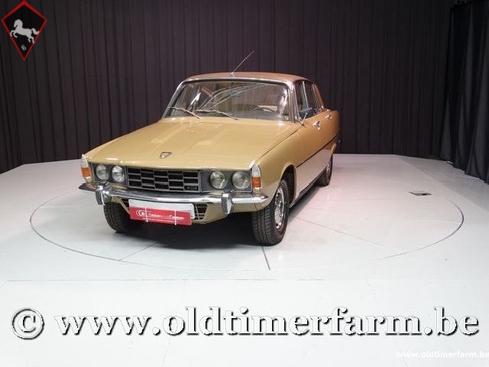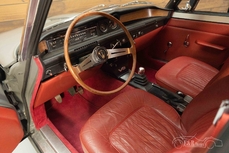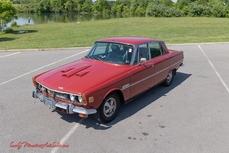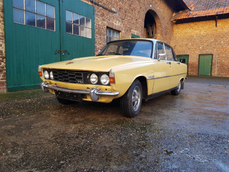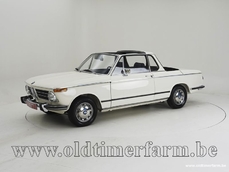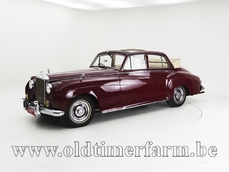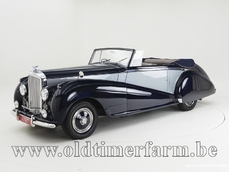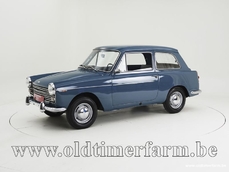Rover P6 (2000/2200/3500) 3500 MKII Auto '74 1974
General description :
Belgian registration documents
Engine renewed
Good general condition
The Rover P6 series (named 2000, 2200, or 3500, depending on its engine displacement) is a saloon car produced from 1963 to 1977 in Solihull, West Midlands. It was voted European car of the year in 1964, the very first winner of this title. The P6 was announced on 9th October 1963, just before the Earls Court Motor Show. It was the sixth of the "P" designated Rover designs, and the last to reach production. The vehicle was marketed first as the Rover 2000 and was a complete "clean sheet" design intended to appeal to a larger number of buyers than earlier models such as the P4 it replaced. The P5 was sold alongside the P6 until 1973.
Rover saw Buick's 3.5 L V8 from the Buick Special as a way to differentiate the P6 from its chief rival, the Triumph 2000. They purchased the rights to the innovative aluminium engine and once it was modified to allow its use by Rover, it became an instant hit. The Rover V8 engine, as it became known, outlived its original host, the P5B, by more than thirty years.
The 3500 was introduced in April 1968 (one year after the Rover company was purchased by Triumph's owner, Leyland) and continued to be offered until 1977. The manufacturer asserted that the light metal V8 engine weighed the same as the four-cylinder unit of the Rover 2000, and the more powerful car's maximum speed of 114 mph (183 km/h) was usefully faster than most of the cars with which, on the UK market, the car competed on price and specifications.
Specifications
Bodywork
Length: cm (in): 457 (179.8)
Width: cm (in): 168 (66)
Height: cm (in): 141 (55.7)
Wheelbase: cm (in): 262 (103.3)
Weight: kg (lb): 1272 (2804)
Mechanics.
Displacement: V8 3532 cc (215 cu in) (Buick origin), front-mounted
Valve gear: 16
Fuel system: 2 SU carburettors
Gearbox: Borg Warner 3-speed automatic
Driven wheels: rear-wheel drive
Maximum power: 146 hp at 5000 rpm
Maximum torque: 267 Nm at 2600rpm
Maximum speed: 185 km/h (115 mph)
http://www.oldtimerfarm.be/en/collection-cars-for-sale/3892/rover-p6-3500-mkii-autom-74.php
1974 Rover P6 (2000/2200/3500) 3500 MKII Auto '74 is listed sold on ClassicDigest in Aalter by Oldtimerfarm Dealer for €8950.
Car Facts
Car type : Car Make : Rover Model : P6 (2000/2200/3500) Model Version : 3500 MKII Auto '74 Engine size : 0.0 Model Year : 1974 Location : Aalter
Sold
Seller Information
Sold
People who viewed this Rover P6 (2000/2200/3500) also viewed similar Rover listed at ClassicDigest
Other cars listed for sale by this dealer
About Rover
Rover, often regarded as more than a "poor man's Rolls-Royce," had a compelling history marked by innovation and quality. Here's a narrative overview, highlighting some significant models and the pioneering features of the Rover P6 series:Rover - A Legacy of Innovation:
Founding and Early Years:
Origins: Rover began as a bicycle manufacturer in the late 19th century before venturing into automobiles.
Engineering Excellence: Rover gained a reputation for quality engineering and durability in their vehicles.
Key Milestones:
Rover 8 (1904-1912): The Rover 8 was the brand's first car and displayed Rover's early commitment to innovation and reliability.
Rover P4 Series (1949-1964): The P4 series, including models like the Rover 75, was known for its classic styling, comfort, and robustness.
Notable Models:
a. Rover SD1 (1976-1986): The SD1 was a significant departure from Rover's traditional styling, featuring a sporty design and advanced features but faced reliability issues.
b. Rover 2000 (P6) (1963-1977): The Rover P6 series was particularly noteworthy for its innovative engineering, setting new standards in the industry.
Rover P6 - Technological Advancements:
The Rover P6 series, especially the 2000 model, introduced groundbreaking features, notably in suspension technology:
De Dion Suspension: The P6's rear suspension utilized a sophisticated De Dion tube setup, offering improved handling, stability, and ride quality. This innovation was typically found in high-performance sports cars rather than mid-range sedans.
Front Suspension: Additionally, the P6 featured a fully independent front suspension system, further enhancing its driving dynamics and comfort, setting new standards for its class.
Legacy and Influence:
Innovative Design and Technology: Rover's commitment to innovation, evident in the P6's advanced suspension, showcased the brand's pursuit of engineering excellence.
Distinct Identity: Rover's focus on combining luxury with innovative technology positioned it as a brand offering a unique blend of sophistication and advanced features.
Conclusion:
Rover's narrative is one of continuous innovation and a commitment to quality engineering. The Rover P6, particularly the 2000 model, was a testament to the brand's dedication to incorporating cutting-edge technology, setting new standards in the automotive industry and proving that innovation could exist beyond the realms of expensive sports cars, elevating the driving experience for mid-range sedans.
